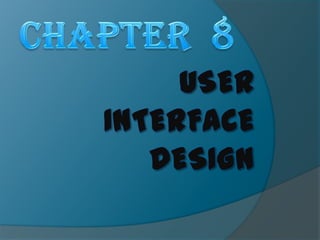The document discusses user interface design and human-computer interaction. It begins by listing the objectives of understanding concepts like user-centered design, interface guidelines, components, and input/output design. It then defines what a user interface is and discusses the evolution of interfaces. Several sections provide guidelines for effective interface design, including making it transparent, easy to learn/use, enhancing productivity, and allowing for help/error correction. Specific controls that can be included are also described. The document emphasizes the importance of usability testing and obtaining user feedback throughout the design process.















































